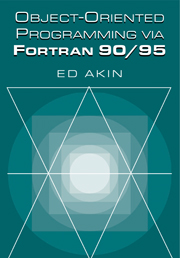Book contents
- Frontmatter
- Contents
- Preface
- One Program Design
- Two Data Types
- Three Object-Oriented Programming Concepts
- Four Features of Programming Languages
- Five Object-Oriented Methods
- Six Inheritance and Polymorphism
- Seven OO Data Structures
- Eight Arrays and Matrices
- Nine Advanced Topics
- Appendix A Fortran 90 Overview
- Appendix B Selected Exercise Solutions
- Appendix C Companion C++ Examples
- Bibliography
- Glossary of Object-Oriented Terms
- Index
Eight - Arrays and Matrices
Published online by Cambridge University Press: 15 October 2009
- Frontmatter
- Contents
- Preface
- One Program Design
- Two Data Types
- Three Object-Oriented Programming Concepts
- Four Features of Programming Languages
- Five Object-Oriented Methods
- Six Inheritance and Polymorphism
- Seven OO Data Structures
- Eight Arrays and Matrices
- Nine Advanced Topics
- Appendix A Fortran 90 Overview
- Appendix B Selected Exercise Solutions
- Appendix C Companion C++ Examples
- Bibliography
- Glossary of Object-Oriented Terms
- Index
Summary
Subscripted Variables: Arrays
It is common in engineering and mathematics to employ a notation in which one or more subscripts are appended to a variable that is a member of some larger set. Such a variable may be a member of a list of scalars, or it may represent an element in a vector, matrix, or Cartesian tensor. In engineering computation, we usually refer to subscripted variables as arrays. Since programming languages do not have a convenient way to append the subscripts, we actually denote them by placing them in parentheses or square brackets. Thus, an element usually written as Ajk becomes A(j,k) in Fortran and Matlab, and A[j] [k] in C++.
Arrays have properties that need to be understood in order to utilize them correctly in any programming language. The primary feature of an array is that it must have at least one subscript. The “rank” of an array is the number of subscripts, or dimensions, it has. Fortran allows an array to have up to seven subscripts, C++ allows four, and Matlab allows only two since it deals only with matrices. An array with two subscripts is called a rank-two array, and one with a single subscript is called a rank-one array, or a vector. Matrices are rank-two arrays that obey special mathematical operations. A scalar variable has no subscripts and is sometimes called a rank-zero array. Rank-one arrays with an extent of one are also viewed as a scalar.
- Type
- Chapter
- Information
- Object-Oriented Programming via Fortran 90/95 , pp. 178 - 208Publisher: Cambridge University PressPrint publication year: 2003

